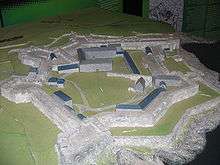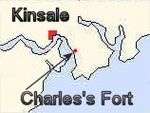Charles Fort (Ireland)
| Charles Fort | |
|---|---|
| Kinsale harbour, County Cork, Ireland | |
|
Plan of fort showing star layout | |
|
Location relative to Kinsale | |
| Coordinates | 51°41′47″N 8°29′56″W / 51.6965°N 8.4990°WCoordinates: 51°41′47″N 8°29′56″W / 51.6965°N 8.4990°W |
| Type | Star fort |
| Site information | |
| Controlled by | Office of Public Works |
| Open to the public | Yes |
| Site history | |
| Built | 1670s |
Charles Fort (Irish: Dún Chathail) is a star fort located on the water's edge, at the southern end of the village of Summer Cove, on Kinsale harbour, County Cork, Ireland.[1] First completed in 1682, Charles Fort was sometimes historically referred to as the "new fort" - to contrast with James' Fort (the "old fort") which had been built on the other side of Kinsale harbour before 1607.[2] The fort is now operated as a heritage tourism site by the Heritage Ireland arm of the Office of Public Works.[3]
Construction and history
Charles Fort was built on the site of an earlier stronghold known as Ringcurran Castle. The Ringcurran defences had featured prominently during the Siege of Kinsale in 1601.[4]
The new fort, which is named after Charles II, was designed by the Surveyor-general Sir William Robinson - architect of the Royal Hospital Kilmainham.[3] Additional site structures are attributed to engineer Captain Thomas Philips.[5] The fort was built between 1677 and 1682 to a star fortification design;[6] a layout specifically designed to resist attack by cannon. It became known as the "new fort" - to contrast with James' Fort (the "old fort") which had been built on the other side of Kinsale harbour between 1602 and 1607.[2]
With a focus on seaward defence, the landward and inland bastions of the fort are overlooked by higher ground. This weakness was of critical importance when the fort was subject to a 13-day siege in 1690 during the Williamite War in Ireland.[5][7] John Churchill, 1st Duke of Marlborough (then 1st Earl) besieged Cork and captured Kinsale and its forts.[7] Repairs were made following the siege.[8]
An early lighthouse was established here in the 17th century by Robert Reading,[9] and additional works (including the development of internal "citadel" defences) were added through the 18th and 19th centuries.[5]
The fort remained in use as a British Army barracks for two hundred years afterwards, before being relinquished by British forces following the Anglo-Irish Treaty of 1921. The fort fell out of use after being burned by retreating anti-Treaty forces during the Irish Civil War in 1922.[7]
Tourism development
The complex remained largely derelict for some time, but was named a National Monument of Ireland in 1971.[8] Over the coming decades several sections of the fort were restored by Dúchas, the Irish heritage service. Restoration and development of the complex was later taken-over by the Office of Public Works (OPW) - including the development of an exhibition space in the former commander's quarters.[10]
Charles Fort is one of the most visited OPW sites in the region,[11] attracting in excess of 86,000 visitors in 2015.[12]
Gallery
 Fortifications
Fortifications- Entrance
- Carronades in the fort
 View from guard house
View from guard house View of officer's house
View of officer's house
See also
- Governor of Kinsale and Charles Fort
- Camden Fort Meagher - a similar coastal fortification defending Cork Harbour
References
| Wikimedia Commons has media related to Charles Fort (Ireland). |
- ↑ "Kinsale Tourism Guide - Charles Fort, Kinsale, County Cork, Ireland". CorkGuide.ie. Retrieved 29 October 2016.
- 1 2 John Sprott Ryan (1836). The Life of William the Third. Grant and Bolton. p. 229.
Marlborough despatched a body of troops to summon Kinsale [..] he then retired his troops to two forrts, called the Old and New fort
- 1 2 "South West - Charles Fort". Heritage Ireland (OPW). Retrieved 29 October 2016.
- ↑ Pádraig Lenihan, ed. (2000). Conquest and Resistance: War in Seventeenth-Century Ireland. Brill. p. 167. ISBN 9789004117433.
- 1 2 3 "Charles Fort, County Cork". National Inventory of Architectural Heritage.
- ↑ "Historic Houses and Castles - Charles Fort". Discover Ireland. Retrieved 29 October 2016.
- 1 2 3 "Charles Fort, County Cork". IrelandsEye. Retrieved 29 October 2016.
- 1 2 Fallon, Linda (2007). Bradt City Guide Cork. Bradt Travel Guides. ISBN 1-84162-196-X.
- ↑ "A Brief History of Irish Lights". The Commissioners of Irish Lights. Archived from the original on 3 February 2007.
- ↑ "Charles Fort & James Fort". DoChara.com. Retrieved 29 October 2016.
- ↑ "Visitors to Tourist Attractions 2007-2011" (PDF). Failte Ireland. October 2012. Retrieved 29 October 2016.
- ↑ "Press Release - OPW announces record visitor numbers to OPW Heritage Sites in 2015". Office of Public Works (OPW.ie). 14 March 2016.

